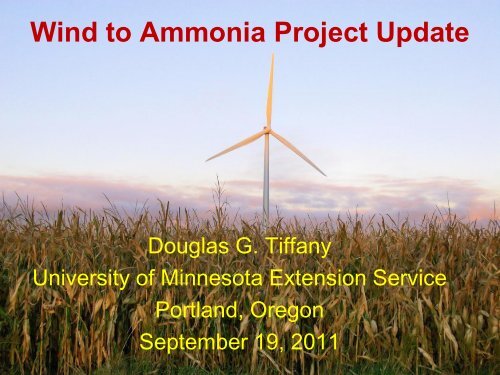Wind to Hydrogen to Ammonia Pilot Project
Wind to Hydrogen to Ammonia Pilot Project
Wind to Hydrogen to Ammonia Pilot Project
Create successful ePaper yourself
Turn your PDF publications into a flip-book with our unique Google optimized e-Paper software.
<strong>Wind</strong> <strong>to</strong> <strong>Ammonia</strong> <strong>Project</strong> Update<br />
Douglas G. Tiffany<br />
University of Minnesota Extension Service<br />
Portland, Oregon<br />
September 19, 2011
Today’s Talk<br />
• Review Motivations for this <strong>Project</strong><br />
• Update Progress<br />
• Identify Plans for Engineering and<br />
Economic Analysis
<strong>Project</strong> Drivers<br />
1. Stranded wind resource due <strong>to</strong> low transmission capacity<br />
2. High ammonia / nitrogen demand and developed infrastructure<br />
3. Nitrogen fertilizer prices have risen while natural gas has declined<br />
4. We seek security for domestic food, feed, and bio-fuel production<br />
5. More value gathered, if windpower is utilized locally<br />
6. Use of ammonia from wind reduces greenhouse gas emissions<br />
7. <strong>Hydrogen</strong> economy transition bridge
Excellent <strong>Wind</strong> Resource
High Demand for <strong>Ammonia</strong><br />
& Excellent <strong>Wind</strong> Resource
Nitrogen Fertilizer Market in Minnesota<br />
Crop<br />
Statewide<br />
Acres*<br />
Avg.<br />
Yield/Ac<br />
(bu.)*<br />
Statewide<br />
Yield<br />
(bu.)<br />
Estimated<br />
N Required<br />
(lbs NH3)**<br />
Corn 8,234,507 146.0 1,201,898,815 901,424,111<br />
Barley 108,268 53.6 5,801,418 4,351,063<br />
Wheat 1,718,565 48.1 82,554,282 61,915,712<br />
Total NH3<br />
Req. (lbs) 967,690,886<br />
Total NH3<br />
Req. (<strong>to</strong>ns)<br />
Retail Value<br />
($800 / <strong>to</strong>n)<br />
483,845<br />
$387,076,354<br />
*Production Data from USDA NASS (2007)<br />
**Based on a requirement of 0.75 lbs of NH3 per bushel of yield
Worldwide <strong>Ammonia</strong> Production<br />
(1,000 of Metric Tonnes)<br />
Source: Orci, <strong>Ammonia</strong>kproduction. U.S. Geological Survey Data
1984<br />
1985<br />
1986<br />
1987<br />
1988<br />
1989<br />
1990<br />
1991<br />
1992<br />
1993<br />
1994<br />
1995<br />
1996<br />
1997<br />
1998<br />
1999<br />
2000<br />
2001<br />
2002<br />
2003<br />
2004<br />
2005<br />
2006<br />
2007<br />
2008<br />
2009<br />
2010<br />
Annual Prices of Anhydrous <strong>Ammonia</strong> and Corn per Ton from 1984-2010<br />
Sources: NASS and ERS<br />
$800<br />
$700<br />
$600<br />
$500<br />
<strong>Ammonia</strong> ($/Ton)<br />
Corn Price ($ per Ton)<br />
$400<br />
$300<br />
$200<br />
$100<br />
$-
1984<br />
1985<br />
1986<br />
1987<br />
1988<br />
1989<br />
1990<br />
1991<br />
1992<br />
1993<br />
1994<br />
1995<br />
1996<br />
1997<br />
1998<br />
1999<br />
2000<br />
2001<br />
2002<br />
2003<br />
2004<br />
2005<br />
2006<br />
2007<br />
2008<br />
2009<br />
2010<br />
$800<br />
Cost of Natural Gas and Gross Margin in Sale Price of Anhydrous <strong>Ammonia</strong><br />
Derived by using Citygate natural gas prices and assuming 32.7 decatherms per <strong>to</strong>n of anhydrous ammonia.<br />
Current Nitrogen Douglas G. Tiffany, University Fertilizer of Minnesota Supply Extension Chain<br />
$700<br />
$600<br />
Gross Margin per Ton of <strong>Ammonia</strong><br />
Natural Gas Cost per Ton of <strong>Ammonia</strong><br />
$500<br />
$400<br />
$300<br />
$200<br />
$100<br />
$-
Transmission vs. Local <strong>Ammonia</strong> Production<br />
High Level / Back of the Napkin Comparison:<br />
‣ Each cost ~$1 million / MW nameplate capacity (+ / - 50%)<br />
‣ Each result in ~$300,000* annual retail revenue / MW nameplate<br />
‣ <strong>Ammonia</strong> production keeps dollars local and potentially has less<br />
development constraints (NIMBY Issues, Permitting, Siting, etc)<br />
‣ <strong>Wind</strong> energy has a utilization problem more than a transmission<br />
and technology problem (net present value of wind is excellent)<br />
*Transmission Case - 1 MW <strong>Wind</strong> Generation Equals 3,328,800 kWh / yr (times $0.08 per kWh ) equals $266,304.00<br />
*Nitrogen Fertilizer Case - 1 MW <strong>Ammonia</strong> Plant Equals 1,460,000 lbs NH3 (times $0.40 per lb) equals $584,000.00
Key Challenges with Electrochemical NH3<br />
Production<br />
A. Capital Costs<br />
-Equipment<br />
-S<strong>to</strong>rage<br />
-Other Infrastructure<br />
B. Energy Costs<br />
-Direct<br />
(5.5 <strong>to</strong> 7 kWh per lb NH3)<br />
-Indirect (eg. Refrigerated S<strong>to</strong>rage, Glenwood, MN = 3 MW load)
Key Challenges with Electrochemical NH3<br />
Production<br />
C. Operation, Maintenance, Repairs<br />
-Need <strong>to</strong> replace plates / cells on electrolyzers every 3 <strong>to</strong> 7 years<br />
-Catalysts (Relatively inexpensive but can damage reac<strong>to</strong>r vessels)<br />
-24 / 7 Operation and Oversight<br />
D. Market<br />
-Competition (Fluctuating NG prices)<br />
-Seasonality of Demand<br />
-Lack of long-term contracts and /or federal and state policy
Key Challenges: Electrochemical NH3 Production<br />
E. Logistics<br />
-What is the appropriate size and scale <strong>to</strong> optimize logistics?<br />
F. Business Model<br />
-What is the optimum size for financial viability?<br />
-What ownership organizations will be most favorable?<br />
G. Electric Energy Industry<br />
-Regulated industry with “service terri<strong>to</strong>ries”<br />
-FERC, MISO, PUC<br />
-Retail wheeling (May need <strong>to</strong> separate wind business from NH3 )<br />
-Socialized costs - transmission, emissions
Key Challenges with Electrochemical NH3<br />
Production<br />
H. Current policies and ownership models may be a poor fit<br />
for <strong>Wind</strong> <strong>to</strong> <strong>Ammonia</strong><br />
-ITC Grant, ITC, PTC----- equity “flips” favor investment by passive<br />
inves<strong>to</strong>rs for wind, Power Purchase Agreements provide stability<br />
I. Commercial Technology<br />
-Lack of equipment and contrac<strong>to</strong>rs for desired scale<br />
-Difficulties attracting investment in new technologies<br />
-Lack of commercially proven equipment usually leads <strong>to</strong> higher equity<br />
investments and / or higher debt costs
Key Opportunities with Electrochemical NH3<br />
Production<br />
A. As Nat. Gas has gotten cheaper prices of NH3 have risen<br />
-Net present value of wind energy is a good value versus mid and long<br />
term natural gas prices<br />
-The cost of electrical energy is relatively stable<br />
B. Opportunity for Vertical Integration<br />
-Farmers represent the NH3 fertilizer demand - Minnesota market<br />
ranges between $400 – $800 million per year<br />
-Farmers own the land needed for wind energy<br />
-Possible <strong>to</strong> take advantage of existing cooperative structures
Key Opportunities with Electrochemical NH3<br />
Production<br />
C. Production Possible in Close Proximity <strong>to</strong> Market<br />
-Less Transportation Costs<br />
–Fewer Middlemen / Margins<br />
-20 MW nameplate wind farm potentially produces N for 57,000 acres of corn<br />
D. Market Flexibility<br />
– Great opportunity for smart grids<br />
– Multiple markets –release purchased power, sell s<strong>to</strong>red power, sell H2, NH3,<br />
carbon credits, other forms of N fertilizer, ammonia for SCR in coal plants,<br />
refrigeration, cosmetics, etc
Key Opportunities with Electrochemical NH3<br />
Production<br />
E. CO2 / Greenhouse Gas Reductions vs. NG in crop production<br />
F. Renewable Energy Mandates and Cost of Transmission<br />
-In regions with excellent wind resources, transmission can be expensive<br />
- Utilities are not requiring additional power<br />
-25 x 25 mandate – <strong>Wind</strong> energy penetration needs <strong>to</strong> be high.<br />
“Why not develop energy intense industry <strong>to</strong> utilize renewable energy in close<br />
proximity <strong>to</strong> where it is produced rather than exclusively build expensive<br />
transmission lines? ”
Renewable <strong>Hydrogen</strong> and <strong>Ammonia</strong> <strong>Pilot</strong> Plant
Renewable <strong>Hydrogen</strong> and <strong>Ammonia</strong> <strong>Pilot</strong> Plant<br />
<strong>Hydrogen</strong> and Nitrogen Production Building<br />
<strong>Ammonia</strong> Production Building
Renewable <strong>Hydrogen</strong> and <strong>Ammonia</strong> <strong>Pilot</strong> Plant<br />
<strong>Hydrogen</strong> S<strong>to</strong>rage Tanks<br />
Nitrogen S<strong>to</strong>rage Tank<br />
Safety Equipment & Shower Building<br />
12.5 kV <strong>to</strong> 480 V Transformer<br />
<strong>Ammonia</strong> Product S<strong>to</strong>rage<br />
(3000 Gallons)<br />
<strong>Ammonia</strong> Pump and Loadout
Renewable <strong>Hydrogen</strong> and <strong>Ammonia</strong> <strong>Pilot</strong> Plant<br />
60 kW HEC <strong>Hydrogen</strong> Engine Genset Switch Gear
Renewable <strong>Hydrogen</strong> and <strong>Ammonia</strong> <strong>Pilot</strong> Plant<br />
<strong>Hydrogen</strong> S<strong>to</strong>rage Tanks<br />
<strong>Hydrogen</strong>, Nitrogen, and <strong>Ammonia</strong> Production Buildings<br />
Nitrogen S<strong>to</strong>rage Tank<br />
Safety Equipment & Shower Building<br />
12.5 kV <strong>to</strong> 480 V Transformer<br />
<strong>Ammonia</strong> Product S<strong>to</strong>rage<br />
(3000 Gallons)<br />
<strong>Ammonia</strong> Pump and Loadout
Another View
Another<br />
View
Pre-<br />
Heater<br />
R-1<br />
812F<br />
2230 psi<br />
Reac<strong>to</strong>r<br />
932F<br />
2215 psi<br />
NH3 Production Skid Process Flow N2 H2<br />
120F<br />
2175 psi<br />
Condenser<br />
HX-6 S-1<br />
Chiller<br />
HX-5<br />
Fin Tube Radia<strong>to</strong>r<br />
-10F<br />
2167 psi<br />
-14F<br />
1509 psi<br />
Separa<strong>to</strong>r<br />
181F<br />
2183 psi<br />
-14F<br />
1509 psi<br />
16.76 lb/h H2<br />
54.21 lb/h N2<br />
4.62 lb/h NH3<br />
NH3 <strong>to</strong> S<strong>to</strong>rage<br />
1509 reduced <strong>to</strong> 250 psi<br />
-14F<br />
7.35 lb/h Recip.<br />
C-1<br />
Compressor<br />
Shell & Tube<br />
Heat Exchangers<br />
100F<br />
1509 psi<br />
5.74 lb/h N2<br />
1.28 lb/h H2<br />
-6F<br />
1509 psi<br />
HX-4<br />
HX-3<br />
HX-2<br />
HX-1<br />
626F<br />
2235 psi<br />
440F<br />
2240 psi<br />
254F<br />
2245 psi<br />
70F<br />
2250 psi
Water Deionization Unit and Safety Shower Pump
<strong>Hydrogen</strong> Electrolyzer (Pro<strong>to</strong>n Energy 10 kW)
<strong>Hydrogen</strong> Electrolyzer (Pro<strong>to</strong>n Energy 10 kW)
H2 Booster Diaphragm Compressor (220 <strong>to</strong> 2450 psi)
H2 and N2 Gas S<strong>to</strong>rage Tanks (2450 psi)
Air Compressor and Dryer<br />
N2 Gas Generation
N2 Booster Compressor (50-120 <strong>to</strong> 2450 psi)
H2 and N2 Gas Dew Point Detec<strong>to</strong>rs and Power Meters
Interior of H2 and N2 Production Building
HEC Oxx Power 60 kW <strong>Hydrogen</strong> Engine Genera<strong>to</strong>r
Data Acquisition <strong>to</strong> Determine Inputs and Outputs
NH3 Load Out, S<strong>to</strong>rage, Nurse Tanks, & Application
New Goal – Carbon Balanced Agriculture<br />
1. Reduce the utilization of fossil fuels in agricultural production systems<br />
2. Increase local markets for renewable energy<br />
3. Decrease economic and financial risk associated with fossil fuel based<br />
agricultural / rural economies<br />
4. WCROC is ideal research location due <strong>to</strong> diverse production systems<br />
• Conventional Crop and Lives<strong>to</strong>ck Systems<br />
• Organic Crop and Lives<strong>to</strong>ck Systems<br />
• No synthetic pesticides, commercial fertilizers, and pharmaceuticals for lives<strong>to</strong>ck<br />
• “Hybrid Carbon-Balanced Crop and Lives<strong>to</strong>ck Systems”<br />
• No fossil fuel based energy and fertilizer - limited use of synthetic pesticides
Opportunities for <strong>Wind</strong> <strong>to</strong> <strong>Ammonia</strong><br />
• Seek opportunities <strong>to</strong> be cost competitive,<br />
independent, and green<br />
• Test novel catalysts and other techniques<br />
• Can smaller scaled units be established?<br />
• Investigate opportunities <strong>to</strong> buy power<br />
from wind resources that get “curtailed.”<br />
• Determine opportunities for local<br />
investments <strong>to</strong> produce fertilizer inputs.
Plan of Investigation<br />
• Determine fac<strong>to</strong>r inputs– kWh per Ton<br />
of H2<br />
• Determine power requirements <strong>to</strong><br />
segregate the N2<br />
• Determine power required <strong>to</strong> synthesize<br />
the NH3<br />
• Study costs of U of M unit<br />
• Model reasonable cost assumptions for<br />
scale-up
Other Avenues of Inquiry<br />
• Determine competitiveness of greener<br />
NH3 when markets or regulations<br />
penalize greenhouse gas emissions of<br />
farm inputs.<br />
• GHG emissions from embedded natural<br />
gas used in NH3 production <strong>to</strong> support<br />
corn production--- huge challenge for<br />
agriculture of U.S. and Minnesota
Contact Information:<br />
Michael Reese<br />
Direc<strong>to</strong>r- Renewable Energy<br />
West Central Research & Outreach Center<br />
University of Minnesota<br />
Phone: (320) 589-1711<br />
Web: http://renewables.morris.umn.edu<br />
reesem@morris.umn.edu<br />
Acknowledgements:<br />
U of MN IREE<br />
MN Corn R & P Council<br />
Natural Resources Trust Fund<br />
NextGen Board<br />
State of Minnesota<br />
Sun Grant<br />
USDA – DOE<br />
Xcel RDF
















